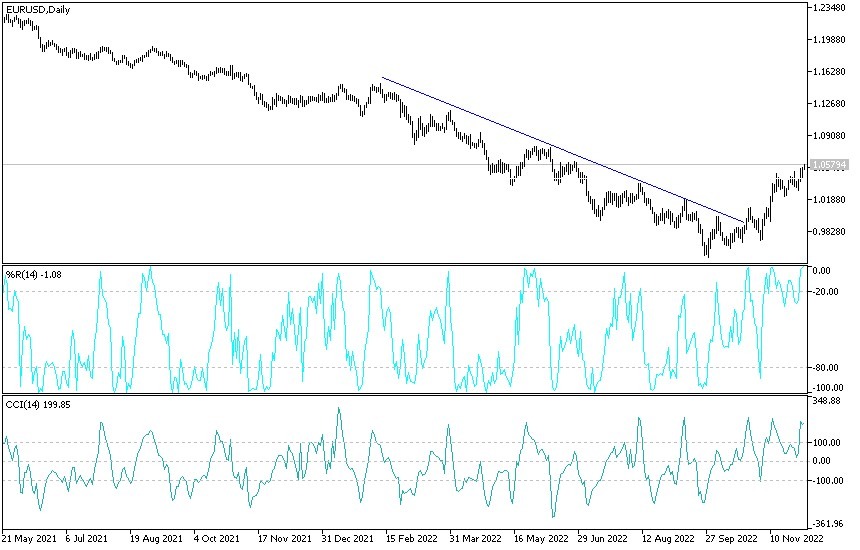For four consecutive trading sessions, the price of the EUR/USD currency pair has been moving amid an upward retracement with strong gains that reached the 1.0545 resistance level. This is the highest for the currency pair in five months and closed last week's trading around the rebound gains. Those strong gains primarily caused investors to abandon the US dollar despite the calming the tone of US Federal Reserve officials about the future of raising US interest rates.
All in all, after the best month for the euro since 2010, investors who relied on the traditional year-end rally may be disappointed. As history shows that the single European currency tends to rise against the dollar in the month of December. But after an increase of more than 5% in November, the benchmark for more seasonal delight is much higher.
This is even before investors consider a host of macroeconomic headwinds in the region as it braces for a potential energy crisis this winter. If we get to participate in some of the major central bank meetings as well, the euro bulls have a lot of risk to deal with. “The seasonal bias in the euro is strong, but the rally in October and in particular November could mean the move started earlier than usual,” said Derek Halpenny, head of research at MUFG, which sees a decline in parity for the euro early on. 2023. “The Fundamentals of a Continued Sell-off in the US Dollar Have Not Yet Been Laid.”
The euro rose last month on bets that the Federal Reserve will slow down its tightening campaign, which led to a weakening of the US dollar and investors' expectations that China will reopen its economy. Some data indicating an easing of the pace of slowdown in the eurozone also raised hopes that the widely anticipated recession may be less severe than initially anticipated.
Seasonal currency trends are often dismissed as mere coincidence, although the argument for specific time flows makes more sense in December. This is when investors close their trades as liquidity evaporates as the holiday season approaches, while European year-end reporting requirements could trigger inflows back home. The historic performance may partly be a by-product of negative European interest rates, says Simon Harvey, head of forex analysis at Monex Europe. There will be capital outflows from Europe as investors sought higher-yielding assets elsewhere, only for those inflows to return home during the year-end reporting periods.
The markets are struggling with a new regime of inflation and higher rates.
Risks may rise in the middle of this month, when both the European Central Bank and the Federal Reserve are expected to slow the pace of interest rate hikes. If the Fed continues to report bullish inflation risks, that could push investors back into the dollar at the expense of the euro. More clues about inflationary pressures may come from the week's data on US Producer Prices and Jobless Claims.
Weather is also increasingly seen as a major threat to the euro's gains. There are signs that temperatures are poised to drop in northern Europe, testing the region's readiness for winter amid limited supplies since Russia's invasion of Ukraine. It's a risk that even euro bulls like Nomura strategist Jordan Rochester have acknowledged. It expects a rise to $1.08 in mid-December before reaching $1.10 towards the end of January. Seasonal trends should be taken with a "pinch of salt," he admits, with weather and energy prices the main risk to his forecast.
EUR/USD Forecast:
- The general direction of the EUR/USD currency pair is still bullish.
- The recent gains were sufficient to push the technical indicators towards overbought levels, as the continuation of its gain factors may head towards the resistance levels 1.0585, 1.0620, and 1.0700, respectively.
- On the other hand, the movement will return towards the support levels 1.0420 and 1.0290, ending the current upward retracement path.
- I still prefer to sell EUR/USD from every upside.
Ready to trade our daily Forex forecast? Here’s a list of some of the best Forex brokers to check out.


